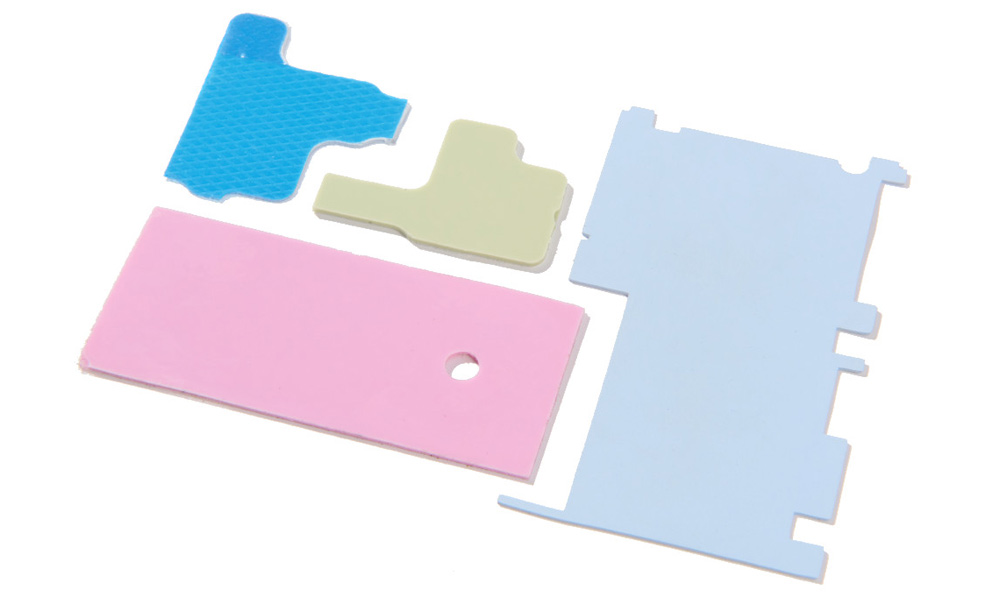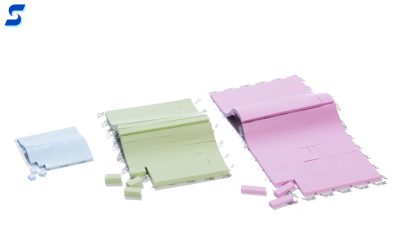Custom Gaskets
Thermal Gap Filler Pads
Custom designed to meet thermal and gap requirements
Custom designed to meet thermal and gap requirements

Stockwell Elastomerics manufactures thermal gap filler pads for managing heat within electronic assemblies. Thermal gap filler pads are made from silicone polymer that is combined with a thermal medium (usually ceramic). The silicone and ceramic powders are mixed, cast and cured to a soft, conformal thermal pad material, in sheet form. Thin, precut thermal pads speed up the assembly process without the mess associated with thermal greases. Gap filler pads are inherently tacky which also aides in the assembly process. Thermal pads are also more stable than phase change products and have higher operating temperatures. Thermal gap filler pads range in thickness from .020″ to .250″ thick. Thermal performance ranges from 1.0 Watt/meter-Kelvin (W/m-K) to 5.0 W/m-K. Gap pads are either waterjet cut into individual pads or flash cut and supplied on sheets with a release liner. Samples are readily available for evaluation.
 Thermal gap fillers are compliant pads used to bridge an air gap between a heat source and a heat sink. Thin gap fillers are used regularly to improve the efficiency of finned heat sinks. Thick thermal gap fillers are used to conduct heat to chassis or electronic enclosures.
Thermal gap fillers are compliant pads used to bridge an air gap between a heat source and a heat sink. Thin gap fillers are used regularly to improve the efficiency of finned heat sinks. Thick thermal gap fillers are used to conduct heat to chassis or electronic enclosures.
Stockwell Elastomerics custom cuts thermal gap filler pads to customer specifications. Using tool-less cutting, extra care is taken to optimize the yield and minimize waste, to help keep material costs down. Stockwell Elastomerics uses thermal interface material from the top manufacturers like Saint-Gobain, Polymer Science, and Bergquist. Thermal gap fillers are made from silicone (or acrylic) polymer that is filled with ceramic particles. The polymer has a gel-like modulus – unlike a cured silicone rubber, it is very soft and compliant and does not rebound well. In general, thermal gap fillers are intended to be compressed once. Gap filler pads are not electrically conductive and most have UL 94V-0 flame ratings.
The video is a visual representation of how thermal gap fillers work. A TC-3008 thermal pad is applied to bottom of one beaker while the other is place directly onto a heat source. The thermal gap filler conforms to the irregularities between the surface which eliminates air pockets and creates a thermal bridge; this in turn allows more energy to transfer to the water. The beaker with the gap filler boils more quickly than the beaker without the pad. (Note: This video is a visual example and not the intended use for thermal gap fillers.)
Thermal gap pads are thermally conductive pads made from thermal interface materials that are very soft and conformal, with a dough-like consistency.
These very soft thermal gap filler materials are designed to conform and fill in gaps between a heat source and heat sink. In some cases the gaps are a function of tolerance variation and in other cases there is intentional spacing. They conform to and fill in between inconsistent surfaces as well as fill microscopic voids on contact surfaces. For example, the surface of a heat generating microprocessor and a heat sink will never mate perfectly. The air gaps between the surfaces will prohibit good heat transfer. By bridging the voids with a thermally conductive gap filler, the heat generated by the microprocessor can be transferred better, through conduction, to the finned heat sink or chassis. Cooler electronics improve performance and reliability. By filling these gaps with thermally conductive materials, the heat generated by the microprocessor can be properly managed, which in turn will aid in performance and reliability. Thermal gap fillers are intended to be compressed – the pressure drives the material into the microscopic surface texture to maximize thermal conductivity.
Customers are now choosing very soft and thin gap filling pads to replace thermal greases and thermal pastes. Since thermal gap filler pads are made into sheets that Stockwell Elastomerics cuts to customer specification, these can be simple or complex geometries. Gap filler pads eliminate the need to work with messy thermal greases or cumbersome thermal paste. Gap filler pads are inherently tacky which allows them to be adhered in place for fast installation.
View more technical information about replacing messy thermal grease with thermal gap pads.
Gap fillers have gained popularity for improving the efficiency of finned heat sinks and chassis heat sinks. Thermal gap filler pads are available in various levels of softness and conductivity, with a wide range of thicknesses. Thermal heat sink pads increase the heat transfer efficiency by “wetting out” into the microscopic surfaces of a heat source and heat sink – this includes surface finish of machined, finned heat sinks. Voids and air pockets act as thermal insulation that inhibit heat transfer between the heat source and the sink. The soft silicone thermal pads also create a thermal bridge that allows conduction to occur between surfaces. Thermal gap filler pads are most commonly used in the electronics industry but can be used in many other applications. Typical heat sinks are aluminum finned plates, chassis or housings.
The thicker, softer gap filler can be laid directly over components or features on PCBs such as pins. Clamping the gap filler pad between the heat sink and board allows the thermal gap filler pad to conform around components and press against the board to create the intimate contact that optimizes heat sink efficiency.
Stockwell Elastomerics is a manufacturer of custom components to help manage and transfer heat. Thermal pads can be cut from a variety of thermal interface materials such as thermal tapes, thermal coated fabrics, thermally conductive silicone rubber, green heat conducting silicone sponge (R10404) or soft thermal gap fillers. Thermal interface materials offered by Stockwell Elastomerics are designed to help transfer heat; in some cases, such as with thermal gap fillers, they are used to remove heat to keep PCBs cool. In other applications such as heat presses, green conducting silicone rubber is used to transfer heat in the printing process. Stockwell Elastomerics also offers high temperature silicone foam for heat insulation.
In some instances, thermal management or heat management means insulating components from heat. Stockwell Elastomerics offers heat reflective foam, which is an insulating silicone foam with a foil facing to help reflect radiant heat (see RF-120 thermally insulating material). In other cases, high temperature silicone foam and silicone sponge rubber materials are used. The cell structure of these expanded silicone materials gives them thermally insulating properties. Similar to home insulation, the small pockets of stagnant air in the cells inhibit heat transfer. UL 94V-0 rated, insulating, silicone foams such as open cell BF-1000 and closed cell HT-800 are commonly specified. Their thermal conductivities are 0.06 W/m-K and 0.07 W/m-K respectively and have an upper operating temperature of 392°F (200°C).
Contact Us for further assistance with thermal gap pads, including thermal gap filler pads, thermally insulating foam, heat conductive pads, thermal conductive pads, and thermal interface pads.